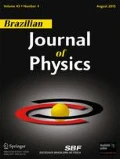Abstract
The work reports the life-cycle test of flake-shaped particle-based magnetorheological (MR) fluid using the MR brake system and evaluated the performance of brake. The choice of the application is based on the understanding that normal force in this case is zero and the same is not true for other applications. Thus, it will exhibit only shear-induced deformation/degradation of MR fluid properties. The test was performed under a constant magnetic field for 105 cycles at 300 rpm. The MR fluid collected after cyclic operation exhibits no change in surface morphology as well as MR properties. Thus, the torque transmission even after this cycle remains the same. This is not the same when commercially available spherical particle-based MR fluid is used. There is a decrement in the torque transmission of MR brake by ~ 30%. The results are discussed on the basis of MR effect and the change in surface morphology of particles. The results confirm that the use of flake-shaped-based MR fluid gives better performance when used for long-term application.









Similar content being viewed by others
References
M.R. Jolly, J.W. Bender, J.D. Carlson, Properties and applications of commercial magnetorheological fluids. J. Intell. Mater. Syst. Struct. 10(1), 5–13 (1999). https://doi.org/10.1177/1045389X9901000102
B.D. Chin, J.H. Park, M.H. Kwon, O.O. Park, Rheological properties and dispersion stability of magnetorheological (MR) suspensions. Rheol. Acta 40(3), 211–219 (2001). https://doi.org/10.1007/s003970000150
J.D. Carlson, in Electrorheological Fluids and Magnetorheological Suspensions. What makes a good MR fluid? (2002), pp. 63–69. https://doi.org/10.1106/104538902028221
I.B. Jang, H.B. Kim, J.Y. Lee, J.L. You, H.J. Choi, M.S. Jhon, Role of organic coating on carbonyl iron suspended particles in magnetorheological fluids. J Appl. Phys. 97(10), 10Q912 (2005). https://doi.org/10.1063/1.1853835
J. De Vicente, D.J. Klingenberg, R. Hidalgo-Alvarez, Magnetorheological fluids: A review. Soft Matter 7(8), 3701–3710 (2011). https://doi.org/10.1039/C0SM01221A
N. Wereley (ed.), Magnetorheology: Advances and applications, vol 6 (Royal Society of Chemistry, London, 2013)
P.L. Wong, W.A. Bullough, C. Feng, S. Lingard, Tribological performance of a magneto-rheological suspension. Wear 247(1), 33–40 (2001). https://doi.org/10.1016/S0043-1648(00)00507-X
J. De Vicente, J. Ramírez, Effect of friction between particles in the dynamic response of model magnetic structures. J. Colloid Interface Sci. 316(2), 867–876 (2007). https://doi.org/10.1016/j.jcis.2007.08.022
C.H. Lee, D.W. Lee, J.Y. Choi, S.B. Choi, W.O. Cho, H.C. Yun, Tribological characteristics modification of magnetorheological fluid. J. Tribol. 133(3) (2011). https://doi.org/10.1115/1.4004106
D. Utami, S.A. Mazlan, F. Imaduddin, N.A. Nordin, I. Bahiuddin, A. Aziz, S.B. Choi, Material characterization of a magnetorheological fluid subjected to long-term operation in damper. Materials 11(11), 2195 (2018). https://doi.org/10.3390/ma11112195
B.K. Kumbhar, S.R. Patil, S.M. Sawant, Synthesis and characterization of magneto-rheological (MR) fluids for MR brake application. Eng. Sci. Technol. Int. J. 18(3), 432–438 (2015). https://doi.org/10.1016/j.jestch.2015.03.002
C. Sarkar, H. Hirani, Synthesis and characterization of antifriction magnetorheological fluids for brake. Def. Sci. J. 63(4), 408–412 (2013). https://doi.org/10.14429/dsj.63.2633
R.V. Upadhyay, Steady shear rheology and magnetic properties of flake-shaped iron particle-based MR fluid: Before and after tribology study. Braz. J. Phys. 49(6), 820–828 (2019). https://doi.org/10.1007/s13538-019-00711-3
LORD Data sheet. www.lordmrstore.com/_literature_231215/data_sheet_-_mrf-132dg_magneto-rheological_fluid. Accessed 18 April 2020
R. Jacob, U.S. Patent No. 2,575,360. (1951) Washington, DC: U.S. Patent and Trademark Office.
W.H. Li, H. Du, Design and experimental evaluation of a magnetorheological brake. Int. J. Adv. Manuf. Technol. 21(7), 508–515 (2003). https://doi.org/10.1007/s001700300060
D.Y. Lee, N.M. Wereley, Quasi-steady Herschel-Bulkley analysis of electro and magneto-rheological flow mode dampers. J. Intell. Mater. Syst. Struct. 10(10), 761–769 (1999). https://doi.org/10.1106/E3LT-LYN6-KMT2-VJJD
Q.H. Nguyen, S.B. Choi, Optimal design of an automotive magnetorheological brake considering geometric dimensions and zero-field friction heat. Smart Mater. Struct. 19(11), 115024 (2010). https://doi.org/10.1088/0964-1726/19/11/115024
Z. Laherisheth, R.V. Upadhyay, Temperature dependence quasi-static measurements on a magnetorheological fluid having plate-like iron particles as dispersed phase. J. Intell. Mater. Syst. Struct. 27(10), 1329–1336 (2016). https://doi.org/10.1177/1045389X15590271
S.R. Patel, D.M. Patel, R.V. Upadhyay, Performance enhancement of MR brake using flake-shaped iron-particle–based magnetorheological fluid. J. Test. Eval. 48(3), 20190794 (2020). https://doi.org/10.1520/JTE20190794
W.H. Kim, J.H. Park, G.W. Kim, C.S. Shin, S.B. Choi, Durability investigation on torque control of a magneto-rheological brake: Experimental work. Smart Mater. Struct. 26(3), 037001 (2017). https://doi.org/10.1088/1361-665X/aa59d8
J.M. Ginder, L.C. Davis, L.D. Elie, Rheology of magnetorheological fluids: Models and measurements. Int. J. Mod. Phys. B 10(23n24), 3293–3303 (1996). https://doi.org/10.1142/S0217979296001744
F.F. Fang, Y.D. Liu, H.J. Choi, Y. Seo, Core–shell structured carbonyl iron microspheres prepared via dual-step functionality coatings and their magnetorheological response. ACS Appl. Mater. Interfaces 3(9), 3487–3495 (2011). https://doi.org/10.1021/am200714p
M.W. Kim, W.J. Han, Y.H. Kim, H.J. Choi, Effect of a hard magnetic particle additive on rheological characteristics of microspherical carbonyl iron-based magnetorheological fluid. Colloids Surf. A Physicochem. Eng. Asp. 506, 812–820 (2016). https://doi.org/10.1016/j.colsurfa.2016.07.070
Acknowledgments
The authors would like to thank the CHARUSAT for providing all technical assistance and testing facilities.
Author information
Authors and Affiliations
Corresponding author
Additional information
Publisher’s Note
Springer Nature remains neutral with regard to jurisdictional claims in published maps and institutional affiliations.
Rights and permissions
About this article
Cite this article
Patel, S.R., Upadhyay, R.V. & Patel, D.M. Life-Cycle Evaluation of Anisotropic Particle-Based Magnetorheological Fluid in MR Brake Performance. Braz J Phys 50, 525–533 (2020). https://doi.org/10.1007/s13538-020-00781-8
Received:
Published:
Issue Date:
DOI: https://doi.org/10.1007/s13538-020-00781-8




